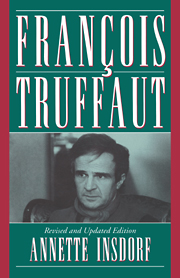Book contents
2 - The Hitchcockian Strain
Summary
TRUFFAUT RECOUNTS in Les Films de ma vie how he saw his first two hundred films illegally, illicitly, and with “a feeling of guilt that could only add to the emotions created by the film” (p. 14). One can therefore sense how he would have been especially susceptible to the cinema of Alfred Hitchcock; for the “Master of Suspense” is also the master of presenting and producing paranoia, anxiety, and the guilt of the voyeur who at once watches and wills violence. If Hitchcock leads “respectable” adult audiences (who have paid for their tickets and are not hiding from school) to identify with his guilty characters, we can imagine his powerful effect on Truffaut: “… the work of Alfred Hitchcock, which is entirely devoted to fear, seduced me from the beginning …” (FV, 14). The seduction would become a lasting relationship, with Truffaut—consciously and unconsciously, stylistically and thematically—incorporating Hitchcock into his own films. And the written document that best celebrates this union is his book-length interview (together with Helen Scott), Le Cinéma selon Hitchcock (1966, English translation by Helen G. Scott in 1967, Hitchcock).
Here Truffaut is the admirer/questioner, and he often places himself in the role of student: “In Hitchcock's work a film-maker is bound to find the answers to many of his own problems, including the most fundamental question of all: how to express oneself by purely visual means” (H, 8).
- Type
- Chapter
- Information
- François Truffaut , pp. 39 - 68Publisher: Cambridge University PressPrint publication year: 1995

